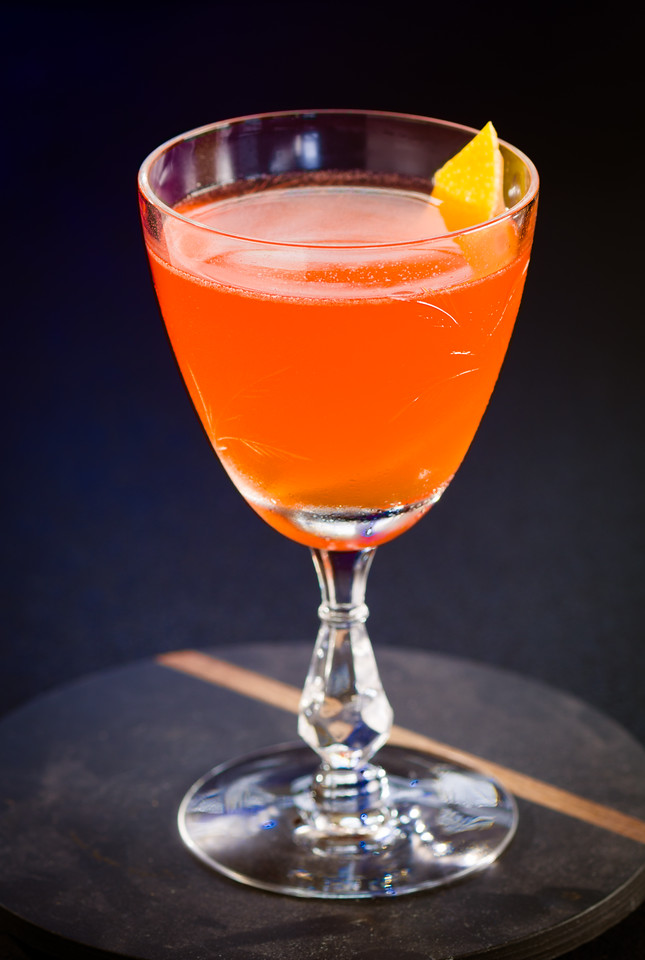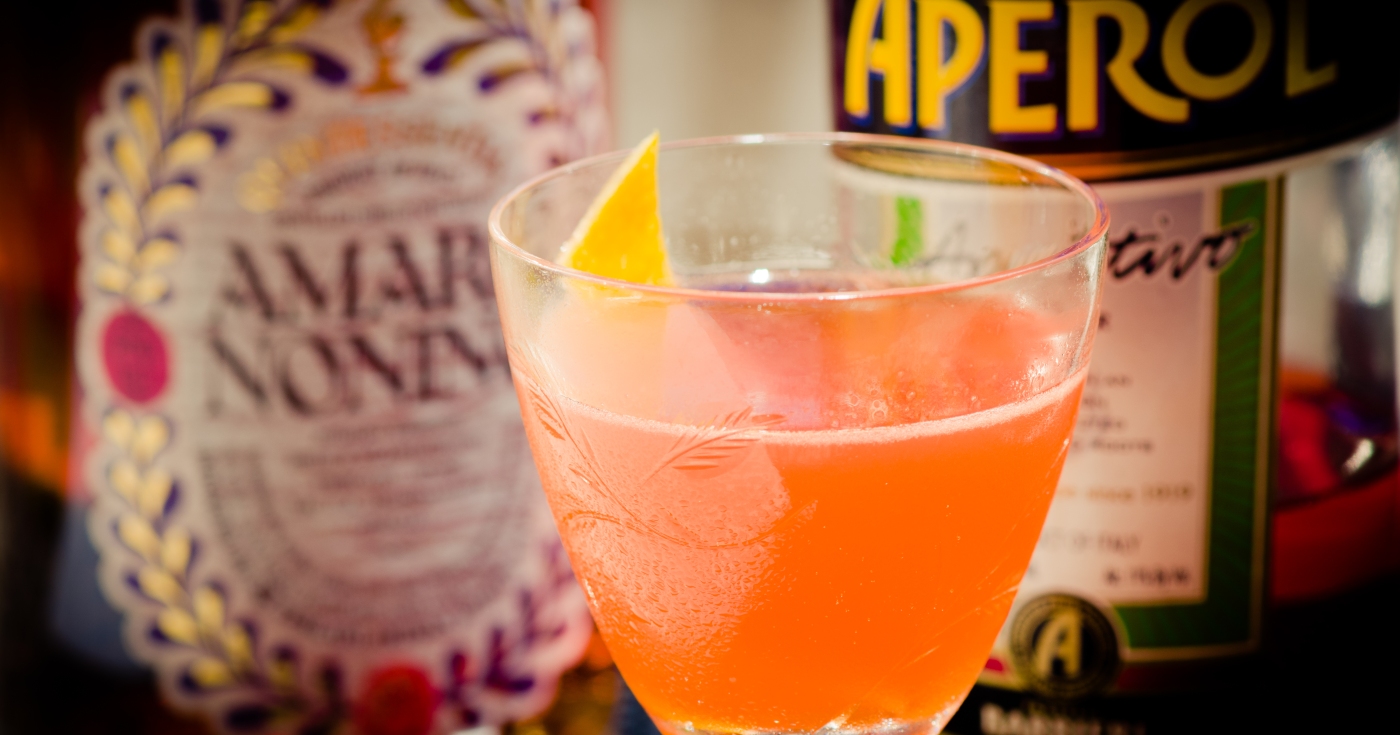The first cocktail I learned to make was the Whiskey Sour. I made it with Scotch, which was a very poor choice, but I was just out of college and didn’t know better. It’s gratifying to discover, in retrospect, that even then I had enough wits about me to think that tinkering with the mix might lead to a worthwhile improvement in flavor. It took forever to realize that the problem was the Scotch. Well, it was too much lemon, too, but at least I finally figured it out.
“Figuring it out” is half the fun with cocktails. Tinkering with the classics has always been a good exercise, and the Whiskey Sour is one of the most versatile of models to play with. Bartenders through the ages have experimented mostly with the sweetener, and occasionally with the citrus. Examples include the classic Ward 8, which blends rye whiskey with orange and lemon juices and grenadine; the Gold Rush, a simple blend of bourbon and lemon sweetened with honey; and the Brown Derby, with bourbon and grapefruit juice, again sweetened with honey.
Liqueurs as sweeteners
A more elegant approach to the sour is to use liqueurs in place of sugar or syrup. It’s not a new styling—Jerry Thomas was sweetening sours with curaçao in the 1880s. A modern example would be the Countrypolitan, a blend of bourbon with lime juice, Grand Marnier and pomegranate liqueur.
A more aggressively flavored, liqueur-sweetened sour is the Last Word: gin, lime juice, Chartreuse, and Maraschino. The Last Word is a gin sour, not whiskey, but it emphasizes the opportunities available with liqueurs; once you open the door to alternative sweeteners, especially the heavily herbal liqueurs like Chartreuse, there’s a lot of room to play.
Amari as sweeteners
One substitution that has gained considerable popularity in the last couple decades is the use of amari as the sweetening agents in sours.
Simply put, amari are bitter-sweet liqueurs, traditionally used as aperitifs or digestifs. Some of the best-recognized examples are Campari, Averna, Aperol, and the ubiquitous, aggressively minty Fernet Branca.
Making the Paper Plane Cocktail
The best example of a modern whiskey sour that uses amari is Sam Ross’s Paper Plane Cocktail.

The Paper Plane is an equal-parts sour, a whiskey-friendly version of the Last Word, with bourbon whiskey, lemon, and two amari as sweeteners, in place of the Last Word’s two herbal liqueurs.
The Paper Plane Cocktail
Sam Ross, 2008
- ¾ oz (25 ml) Bourbon whiskey
- ¾ oz (25 ml) Aperol
- ¾ oz (25 ml) Amaro Nonino
- ¾ oz (25 ml) fresh lemon juice
- lemon twist for garnish
Shake first four ingredients with ice until very cold. Strain into a chilled cocktail stem, or over a large piece of ice in a rocks glass. Express and garnish with lemon twist.
The Aperol and Amaro Nonino both have a pronounced orange nose. Both bring considerable sweetness to the drink, along with a leathery, rhubarb and orange peel bitterness. The Nonino has a distinct caramel note, and is slightly vanilla—possibly as a result of its unusual barrel aging. Neither is aggressively bitter, but they bring a richness and complexity to the flavor that goes far beyond anything a simple sugar syrup can provide.
A high-proof bourbon like Weller 107, with its cinnamon and orange notes, is a good choice in this cocktail, to stand up against the amari. Buffalo Trace, at 90-proof, with its caramel nose and barrel flavors, also works well.
(And if you’re like me, you might find that the Paper Plane is slightly improved by going just a bit heavy on the bourbon.)
The Campari Alternative
Brad Parsons, in his 2016 Amaro, the Spirited World of Bittersweet, Herbal Liqueurs, says that Ross originally mixed the Paper Plane with Campari, but later decided the Aperol was better balanced. Marvel Bar in Minneapolis serves a version of that early Campari model that looks something like this:
Marvel Bar, Minneapolis
- 1⅔ oz (50 ml) rye whiskey
- ⅔ oz (20 ml) lemon juice
- ⅔ oz (20 ml) Amaro Nonino
- ⅔ oz (20 ml) Campari
Shake with ice and strain into cocktail stem.
Marvel makes two obvious changes to deal with the more aggressive bitterness of the Campari: despite the “equal parts” concept of the original Paper Plane, they more than double the whiskey proportion; and they switch to rye to give even more of a whiskey profile. My preference is for the non-Campari version, but Marvel’s formula offers an interesting insight into the possibilities of substitutions.
 The use of amari to sweeten and enrich the whiskey sour (or any sour) is a brilliant idea. It brings new flavors to the fore, diversifies the list of available ingredients, and provides a way to make the relatively simple sour into a sophisticated, even complicated, treat.
The use of amari to sweeten and enrich the whiskey sour (or any sour) is a brilliant idea. It brings new flavors to the fore, diversifies the list of available ingredients, and provides a way to make the relatively simple sour into a sophisticated, even complicated, treat.
I don’t know what made me remember mixing that first whiskey sour. For that matter, I don’t know why I was even interested in making a whiskey sour, even a bad whiskey sour, when most of my friends drank beer or indulged other recreations. It was the 70s, not memorable times for cocktailing, and I’m hardly a dyed-in-the-wool iconoclast.
I doubt there will ever be answers to those questions, but that’s okay. It’s enough to have started down a path that I’ve enjoyed, and along the way there has been a spectrum of whiskey sours, from that first, awful, lemon-heavy Scotch sour to the marvelous richness and imagination of the amaro-laden Paper Plane.
“Whiskey Sours and Embittered Last Words: the Paper Plane Cocktail” at cold-glass.com : All text and photos © 2016 Douglas M. Ford. All rights reserved.

I love the color of this cocktail! Anything with Campari or Aperol always gives such a delightful tint to whatever drink it’s in, though I will admit that for me, it has been an acquired taste. That hint of bitterness at the back of one’s tongue when drinking either of these liqueurs is something to get used to. But having said that, I recently had my first Negroni and enjoyed it immensely. In one of my previous blog posts, I actually created a cocktail using Campari and gave the recipe for it, though I’d be surprised if some variant of it hadn’t already been invented in this wide world of drinks. If you’re interested in taking a look and giving me your thoughts, the post is here: https://foodinbooks.com/2016/05/30/dont-look-now-by-daphne-dumaurier/
Thanks for another very enlightening and entertaining post!
I suppose all of the amari, and cocktail bitters, for that matter, are something of an acquired taste. Also coffee and tea, I suppose. And some of those tastes we acquire more easily than others.
And you’re right, the red color of Campari and Aperol is enticing. Glad you enjoyed the post!